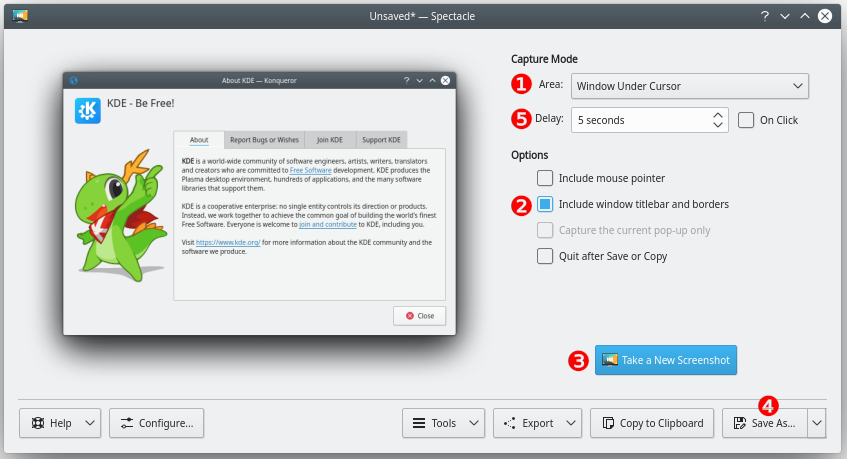Taking Screenshots: Difference between revisions
Appearance
m Changed protection level for "Taking Screenshots" ([edit=autoconfirmed] (expires 20:04, 2 April 2011 (UTC)) [move=autoconfirmed] (expires 20:04, 2 April 2011 (UTC))) |
Yecril71pl (talk | contribs) corrections to Workflow |
||
| Line 1: | Line 1: | ||
== Guidelines == | == Guidelines == | ||
* Set the language to English unless it's a localized screenshot | * Set the language to English, unless it's a localized screenshot. | ||
* Save as a PNG image | * Save as a PNG image. | ||
* Preferably, use the default settings (icons, color scheme, style, window decoration, application settings etc.) | * Preferably, use the default settings (icons, color scheme, style, window decoration, application settings etc.). | ||
* Preferably, use compositing (Desktop Effects module in [[System Settings|System Settings]]) but don't worry if your graphics card does not support compositing. | * Preferably, use compositing (Desktop Effects module in [[System Settings|System Settings]]), but don't worry if your graphics card does not support compositing. | ||
* Preferably, use Liberation Sans | * Preferably, use font "Liberation Sans" at 9pt. | ||
* If the screenshot shows parts of the desktop, preferably use | * If the screenshot shows parts of the desktop, preferably use the default background of plasma. Include a margin (around 20 pixels) if possible, to ensure that window shadows don't look cropped. | ||
== Workflow == | == Workflow == | ||
| Line 14: | Line 14: | ||
# Start '''[[KSnapshot]]''' | # Start '''[[KSnapshot]]''' | ||
# Choose a '''Capture mode''' (1) | # Choose a '''Capture mode''' (1) | ||
# | #;Current Screen | ||
# | #: Everything on the screen is captured, usually used for ''desktop screenshots''. (Use ''Full Screen'' mode to capture all screens in a multiscreen environment.) | ||
# | #;Window Under Cursor | ||
#: The content of an applications or dialog window is captured. usually used for ''application screenshots''. Preferably, check the '''Include window decorations''' option (2). | |||
#;Region | |||
#: Only a region to be defined later is captured. | |||
# Click on '''New Snapshot''' (3). | # Click on '''New Snapshot''' (3). | ||
# | #;Full Screen | ||
# | #;Current Screen | ||
# | #;Window Under Cursor | ||
# | #: Click anywhere on the screen to take the snapshot. | ||
#;Region: | |||
#:# Use the mouse to draw a rectangle around the region to be captured (for example around a window). | |||
#:# Strike the <keycap>Enter</keycap> key or click on '''Enter''' or double click in the region to take the snapshot. | |||
# Click on '''Save As...''' (4). | # Click on '''Save As...''' (4). | ||
# Browse to the location you want to save the image, give it a name ( | # Browse to the location you want to save the image, give it a name (<var >name</var >.png'') and click on '''Save''' | ||
== Hints and Tips == | == Hints and Tips == | ||
Revision as of 19:19, 2 April 2011
Guidelines
- Set the language to English, unless it's a localized screenshot.
- Save as a PNG image.
- Preferably, use the default settings (icons, color scheme, style, window decoration, application settings etc.).
- Preferably, use compositing (Desktop Effects module in System Settings), but don't worry if your graphics card does not support compositing.
- Preferably, use font "Liberation Sans" at 9pt.
- If the screenshot shows parts of the desktop, preferably use the default background of plasma. Include a margin (around 20 pixels) if possible, to ensure that window shadows don't look cropped.
Workflow
In this example KSnapshot is used, but other screen capture applications work as well.

- Start KSnapshot
- Choose a Capture mode (1)
- Current Screen
- Everything on the screen is captured, usually used for desktop screenshots. (Use Full Screen mode to capture all screens in a multiscreen environment.)
- Window Under Cursor
- The content of an applications or dialog window is captured. usually used for application screenshots. Preferably, check the Include window decorations option (2).
- Region
- Only a region to be defined later is captured.
- Click on New Snapshot (3).
- Full Screen
- Current Screen
- Window Under Cursor
- Click anywhere on the screen to take the snapshot.
- Region
-
- Use the mouse to draw a rectangle around the region to be captured (for example around a window).
- Strike the Enter key or click on Enter or double click in the region to take the snapshot.
- Click on Save As... (4).
- Browse to the location you want to save the image, give it a name (name.png) and click on Save
Hints and Tips
- The Snapshot delay option (5) makes KSnapshot wait a given amount of time (given in seconds) before taking the snapshot. This can be useful in many situations, for example when taking screenshots of drop-down menus
- It's often useful to create a separate user for taking screenshots, to ensure a standard look with the default settings. An alternative is to create an Activity with the settings required for screenshots
- Use Type: Color in the wallpaper settings to get a white background
